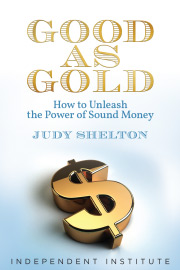More than a decade has passed since the devastating global financial meltdown. Ben Bernanke, Federal Reserve chairman at the time, described it as “the worst financial crisis in global history, including the Great Depression.” The 2008 debacle’s economic and political repercussions are still playing out, with damaging effects on social cohesion.
Given that the central bank of the United States had more influence than any other government institution over the creation of money and credit in the lead-up to the disaster, it is important to be able to include the Fed in discussions of how best to safeguard financial stability and promote productive economic growth. Questioning the Fed’s infallibility in making monetary policy decisions should not be interpreted as an attack on its “independence” but rather an honest effort to stir much-needed debate.
One major aspect of monetary policy that has not received sufficient examination is the international role of the U.S. dollar and how trade flows are affected by interest-rate policies implemented by the world’s other major central banks. Central bank actions are a powerful force driving exchange rates among leading currencies, which helps explain why financial markets obsess over every syllable in statements by central bank officials.
History can be especially informative when it comes to evaluating the relationship between optimal economic performance and monetary regimes. In the 1930s, for example, the “beggar thy neighbor” tactic of devaluing currencies against gold to gain a trade export advantage hampered a global economic recovery. Yet today little attention is focused on the role of the differential interest-rate policies pursued by central banks in causing the currency shifts that alter the terms of trade among competing producers in world markets and raise tensions among trading partners.
The absence of rules aimed at maintaining a level monetary playing field invites currency manipulation that could spark a backlash against the concept of free trade. Countries engaged in competitive depreciation undermine the principles of genuine competition, and those that have sought to participate in good faith in the global marketplace are unfairly penalized by the monetary sleight of hand executed through central banks.
U.S. leadership is necessary to address this fundamental violation of free-trade practices and its distortionary impact on free-market outcomes. When the United States’ trading partners engage in currency manipulation, it is not competing—it’s cheating.
That is why it is vital to weigh the implications of U.S. monetary policy on the dollar’s exchange-rate value against other currencies. Trade and financial flows can be substantially altered by speculative market forces responding to the public comments of officials at the helm of the European Central Bank, the Bank of Japan or the People’s Bank of China—with calls for “additional stimulus” alerting currency players to impending devaluation policies.
When currencies shift downward against the dollar, it makes U.S. exports more expensive for consumers in other nations. It also discounts the cost of imported goods compared with domestic U.S. products. Downshifting currencies against the dollar has the same punishing impact as a tariff. That is why, as in the 1930s during the Great Depression, currency devaluation prompts retaliatory tariffs.
Ultimately, it is the set of economic policies that a nation adopts that determines its success. Greater opportunity and prosperity depend on a pro-growth agenda that substantially reduces the regulatory burden on business, cuts taxes, unleashes energy initiatives and diligently seeks improved trade relationships. Stable money is also an important pillar: The Fed should focus on nurturing a strong U.S. economy while ensuring a level international monetary playing field. Monetary policy must take into account both objectives.
The goal shouldn’t be to achieve a strong dollar or a weak dollar, but a dependable dollar. In a world with some $13 trillion in negative-yielding debt largely engineered by the European Central Bank, and a bizarre yield curve that has the Fed paying 2.35 percent interest on excess bank reserves while the 10-year U.S. Treasury rate hovers around 2.05 percent, a rising dollar would not be helpful. Borrowers around the world hold trillions in dollar-denominated debt; a monetary misstep that exacerbated exchange-rate pressures could raise the specter of global financial instability.
Given the need to reconcile domestic and international monetary objectives, the old labels of “hawks” vs. “doves”—focused strictly on domestic monetary policy—at the Federal Reserve are no longer useful. What’s needed is a woodpecker to hammer away with a message about the importance of money serving as a reliable measure of value—across borders and through time.









